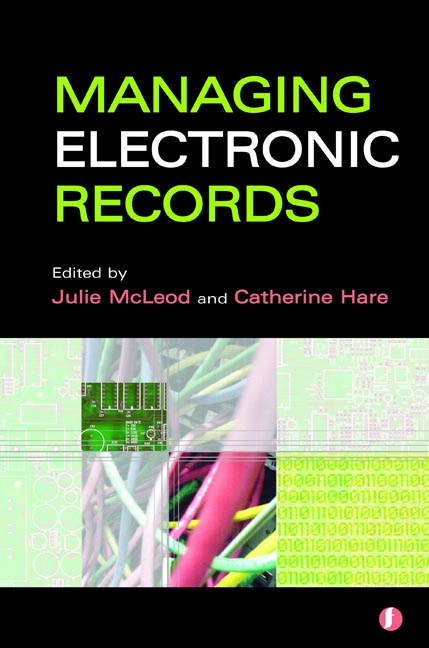Book contents
- Frontmatter
- Contents
- The editors and contributors
- Preface
- 1 The wild frontier ten years on
- 2 The use of standards and models
- 3 Metadata matters
- 4 Digital preservation – ‘the beautiful promise’
- 5 Research in electronic records management
- 6 Technologies for preservation
- 7 Legal issues
- 8 Ethics and electronic recordmaking
- 9 Competencies – the asset that counts most: on developing human talents as a prerequisite for successful EDRM changes
- 10 Records management: two case studies from the French private sector
- 11 Implementing a solution for electronic recordkeeping in the public sector
- 12 Playing the long game – creating and maintaining the links in the value chain
- Index
1 - The wild frontier ten years on
Published online by Cambridge University Press: 08 June 2018
- Frontmatter
- Contents
- The editors and contributors
- Preface
- 1 The wild frontier ten years on
- 2 The use of standards and models
- 3 Metadata matters
- 4 Digital preservation – ‘the beautiful promise’
- 5 Research in electronic records management
- 6 Technologies for preservation
- 7 Legal issues
- 8 Ethics and electronic recordmaking
- 9 Competencies – the asset that counts most: on developing human talents as a prerequisite for successful EDRM changes
- 10 Records management: two case studies from the French private sector
- 11 Implementing a solution for electronic recordkeeping in the public sector
- 12 Playing the long game – creating and maintaining the links in the value chain
- Index
Summary
Introduction
Ten years ago I wrote an article entitled ‘Managing Records in the Modern Office: taming the wild frontier’ (McDonald, 1995). It focused on the challenges organizations were experiencing in managing their e-mail and other electronic documents in the unstructured office environment. This environment, common in most organizations at the time and, as this chapter will argue, still too common today, was one where business processes and workflow were not clearly defined, the user had relative autonomy over what information was created, sent and stored, and accountability for the management of information was unclear.
At that time I felt that the wild frontier was as temporary as the frontier the US and other areas of the world experienced back in the 19th century. In the early pioneer days ad hoc approaches to settlement and a rather chaotic approach to law and order gave way to a more settled environment where the rule of law and the means to enforce it were established. Responsibility for administering the environment was assigned and technologies (telegraph, roads and so on) were introduced to foster economic and social growth. In my naïveté I thought that it was a matter of time before the wild frontier of the modern office would evolve in the same way, spurred on by technology developments, new ways of organizing and designing work processes, and new techniques for making recordkeeping transparent and nearly automatic.
When I wrote the article I had naïve hopes and expectations of the technology that the future of recordkeeping was just around the corner. I envisioned a desktop where the icons on the screen would change to work driven icons supported by integrated workflow, wordprocessing, forms and routing software. It would also enable automated and transparent recordkeeping based on business rules developed for program managers by highly knowledgeable and skilled records managers and workflow/business analysts – all working together in harmony!!
A year or so later, Margaret Hedstrom (1997) reinforced this perception by explaining that there were others ‘out there’ who shared the same concerns as archivists and records managers about the management of electronic records and who were actively engaged in developing solutions.
- Type
- Chapter
- Information
- Managing Electronic Records , pp. 1 - 17Publisher: FacetPrint publication year: 2005
- 5
- Cited by



